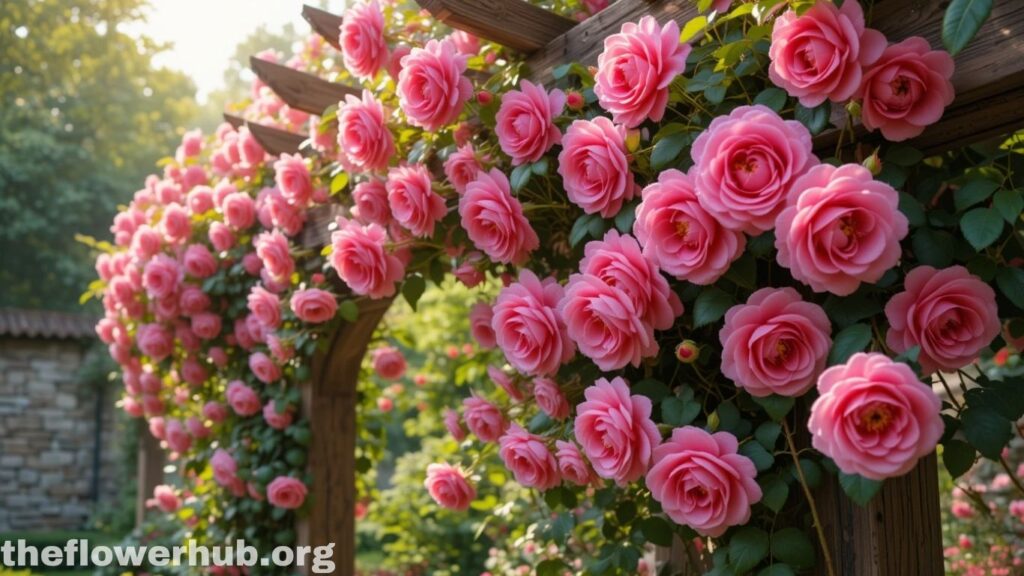Introduction
Climbing roses are among the most romantic and dramatic plants, prized for centuries for their ability to create vertical beauty, offering the spiritual height of fragrance and color to gardens around the planet.These roses have been prized for centuries for their ability to make vertical beauty, offering the spiritual height of fragrance and color to gardens around the planet. Whether climbing over an arbor, trellis, or fence, or one of the traditional uses is on the walls of a house, each type of climbing rose is unique; some climb quite high, while others are capable of covering a small wall or fence.
In this ultimate guide, we will give you all the info you need about climbing rose bushes — the types of roses, how to plant them, how to prune them, care for them, and how to use them creatively to turn your garden into a paradise of blooms.

Table of Contents
Table: Quick Reference
| Aspect | Details |
|---|---|
| Botanical Name | Rosa spp. (Climbing cultivars) |
| Most Popular Types | New Dawn, Don Juan, Iceberg Climber, Cecile Brunner |
| Size | 8 to 20’+ tall (depending on variety) |
| Spread | 6 to 10 feet |
| Light Requirements | Full sun (6+ hours direct sun) |
| Soil Cavity | Well-drained loam, amended with compost |
| Bloom Time | Late spring to the fall |
| Life cycle | Perennial Can remain vigorous for decades. |
| Features | Flowers repeatedly, fragrant, encourages vertical growth patterns |
| Best Uses | Trellises, arches, walls fencing, pergolas, and arbors |
What is Different About Climbing Roses?
Climbing roses are distinct from bush and shrub roses, in that they have a more plentiful supply of long canes that extend away from the base of the plant. They don’t creep with tendrils or suckers like vines; instead, they require help and tethers to produce their hallmark cascading appearance.
Characteristics of Climbing Roses The features climbing roses are : .
- Rapid, vigorous growth — sometimes as much as 20 feet.
- Remontance — most modern varieties bloom again, or perhaps even two or more times, in a season.
- Fragrance to fragrance while most climbing roses have heady scents, but can vary from light to strong.
- Versatility — perfect for screens, trellises, walls, arbors, and pergolas.
Well Liked Climbing Rose Varieties
The key to success is choosing the right climbing rose. Here is a closer look at the most popular types:
💖 New Dawn
This is a classic pink climbing rose that blooms repeatedly and is hardy to boot. It is one of the first roses to win the All-America Rose Selections prize.
❤️ Don Juan
This dark red climbing rose has velvety, scented flowers and creates a strong feature on trellis and walls.
🤍 Iceberg Climber
Beautiful white rose with bountiful blooms. It is valued for its resistance to disease and extended flowering season.
💕 Cecile Brunner
Also known as the ‘Sweetheart Rose’, it forms small, fine pink flowers with a divine scent.
🌼 Golden Showers
One of the very few yellow climbers, it lights up any garden with a constant display of happy blooms.
The Top Spots to Plant
A good location is decisive for the flourishing of climbing roses:
- ✅ Full sun 6 to 8 hours of direct sunlight is best.
- ✅ Air flow — So you don’t have to worry about fungus.
- ✅ Rich, well-draining soil — Work compost into soil before planting.
- ✅ support structure — Key to training those canes right.
How to Plant Climbing Roses From preparation of the bed and support, setting the rose in, to mulching and plant care.
How to plant climbing roses that will endure:
- 1️⃣ Digging the hole — It should be twice as wide as the root ball, same depth.
- 2️⃣ Preparing your soil — Combine with compost & well-rotted manure.
- 3️⃣ Position the Plant — Plant the tree, positioning the graft union slightly above soil level.
- 4️⃣ Give it a good deep drink — Water it deeply into the root zone after planting.
- 5️⃣ Apply mulch — It helps keep the soil moist and controls the weeds.
- 6️⃣ Provide support — Tie canes in lightly to their support.
How to Train and Prune
Training Climbing Roses:
- Tie canes horizontally or at 45° to induce flowering along the stem.
- Loosely secure them with soft ties such as garden twine or Velcro to avoid damaging stems.
Pruning Climbing Roses:
- When to do it: Late winter or early spring, before new growth begins.
How:
- Prune away dead, dead, or weak wood.
- Prune dwarfing side shoots to 2–3 buds.
- Thin crowded growth to let in air.
Seasonal Maintenance Tips
Spring
- Feed with a well balanced rose food.
- Start keeping an eye out for pests and diseases.
Summer
- Keep soil evenly moist.
- Remove spent blossoms to ensure long flowering.
Autumn
- Cut back on watering to bring plants into dormancy.
- Fallen leaves and trash can be eliminated.
Winter
- Prune if not done in autumn.
- Mulch the plants at the base to frost protection.
Common Climbing Rose Problems & Solutions
| Problem | Cause | Solution |
|---|---|---|
| Black spot | Fungus disease | Cut off infected leaves and spray with fungicide. |
| White powdery substance | Dry soil, bad air circulation | Water at source, open air around plant. |
| Aphids | Sap suckers | Use neem oil or insecticidal soap. |
| Not flowering | Lack of sun or food | Move or feed with general rose feed. |
| Weak wood | Failure to prune or stand | Prune as it should or stand properly. |
Design Inspiration: Creative Uses for Climbing Roses
- 1, Arches & Entrances: Decorate your garden gate or road.
- Walls & Fences Soften hard surfaces with cascades of blooms.
- Pergolas and Gazebos: A private rendezvous beneath a canopy of roses.
- Mixed plantings: Use with clematis or honeysuckle for contrast of color and texture.
Expert Tips On Growing
- 👉 Soil pH: Maintain pH levels of 6.0–6.5 for best nutrient absorption.
- 👉 Watering deeply: Promote deep root development by watering deeply rather than often.
- 👉 Integrated pest management: Entice helpful insects such as ladybugs to control pests in a natural way.
- 👉 Keep an eye on things: Catching a disease or pests early means healthier plants.
Companion Plants for Climbing Roses
A few guiding readings: These companions will beautify and provide an extra dose of health to your roses:
| Companion Plant | Benefit |
|---|---|
| Lavender | Deters aphids, attracts pollinators. |
| Catmint | Repels pests, contributes soft blue. |
| Alliums | Ward off black spot and mildew. |
| Salvia | Draws bees and other good bugs. |
History of Climbing Roses Importance of Climbing Roses

Roses have been used to adorn castles, cottages and formal gardens for over a thousand years. From the walled gardens of medieval European to the trellises of Victorian England, these roses have come to represent not just romance and beauty, but also resilience. It’s due to their timeless appeal and versatility that they continue to remain popular today.
FAQs
Q: How can I get my climbing rose to bloom more?
Being sure they get enough sunlight, are well pruned, and are fed at regular intervals with a rose diet are essential.
Q: Can climbing roses destroy walls?
No, they are not invasive with their roots or with suckers. Tray supports, though, are to be provided for surface protection.
Q: Will climbing roses grow in pots?
Yes, but opt for large, deep pots and offer strong support.
Q: How often should climbing roses be fertilized?
Feed early spring and after each flush.
Q. Are climbing roses evergreens?
They are generally decidous, however in warm climates (and under special conditions) you can have evergreen varieties.
Conclusion
There’s nothing quite like climbing roses — they’re more than a plant, they’re an experience. These behemoths not only soar hundreds of feet skyward, but they have a sweet aroma and a long history that can turn any backyard into a paradise. With the proper choice of variety, careful planting, and thoughtful care, you’ll enjoy years of glorious blooms and garden artistry.
So why not let these climbing roses give your garden that wow factor? Trained over an arch, a fence, or draped across a pergola, these roses will grace your garden with its spectacular display of vivid color year after year.
